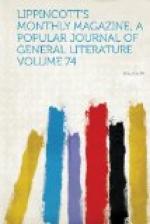The cemetery had been visited by great numbers of persons, bringing chaplets and flowers, during the day, both in the aristocratic and the plebeian quarters, but it was at night that the crowd was greatest and the scene most striking. The night, as it so chanced, was a dark one, which did not make the scene by any means less strange and weird-looking. The greater number of visitors, especially in the poor quarter of the dead city, were women. Such is always the case, whether it be that the female mind is more generally accessible to gentle thoughts of and yearnings over their lost ones, or whether the explanation be simply that, as is especially the case here, women, having less to occupy their leisure either in the way of business or amusement, are more eager to seek any emotion or occasion which may serve to break the flat monotony of their lives.
Certainly the scene in the cemetery on the evening of the “Day of the Dead” was one calculated to make an impression not to be readily forgotten by any mere looker-on who witnessed it. Nor was that presented by the road from the gate to the cemetery less remarkable in its way. It is an ugly, disagreeable bit of road, between high walls, deep with mud in wet, and with dust in dry weather, as was the case on the present occasion, and without the smallest vestige of a pathway for foot-passengers; so that the motley crowd, with their lights and chaplets and flowers, had to make their way amid a cloud of dust and among the carriages of those bound for the “Pincetto” as best they might. But it was the general apparent mood and temper of mind in which these pilgrims, bound on so sad an errand, seemed to be performing their self-imposed task that was especially noteworthy. It might be supposed that a certain degree of reverential self-concentration, or at least of quietude, would have been the characteristic of a crowd bound on such an errand. There was not the smallest symptom




